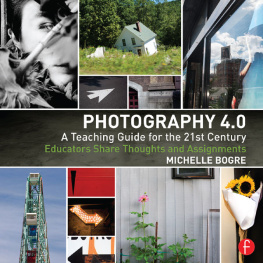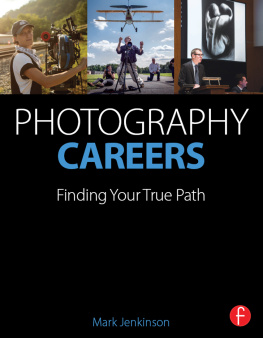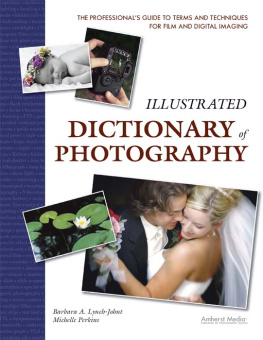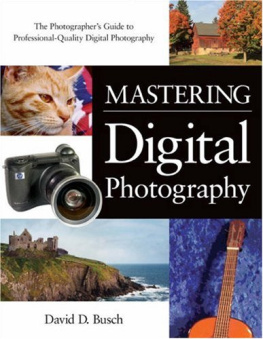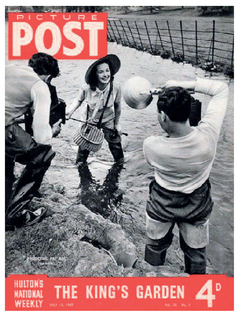THE ESSENTIAL STUDENT GUIDE TO PROFESSIONAL PHOTOGRAPHY
The Essential Student Guide to Professional Photography
Grant Scott
First published 2016
by Focal Press
70 Blanchard Road, Suite 402, Burlington, MA 01803
and by Focal Press
2 Park Square, Milton Park, Abingdon, Oxon OX14 4RN
Focal Press is an imprint of the Taylor & Francis Group, an informa business
2016 Taylor & Francis
The right of Grant Scott to be identified as author of this work has been asserted by him in accordance with sections 77 and 78 of the Copyright, Designs and Patents Act 1988.
All rights reserved. No part of this book may be reprinted or reproduced or utilised in any form or by any electronic, mechanical, or other means, now known or hereafter invented, including photocopying and recording, or in any information storage or retrieval system, without permission in writing from the publishers.
Notices
Knowledge and best practice in this field are constantly changing. As new research and experience broaden our understanding, changes in research methods, professional practices, or medical treatment may become necessary.
Practitioners and researchers must always rely on their own experience and knowledge in evaluating and using any information, methods, compounds, or experiments described herein. In using such information or methods they should be mindful of their own safety and the safety of others, including parties for whom they have a professional responsibility.
Product or corporate names may be trademarks or registered trademarks, and are used only for identification and explanation without intent to infringe.
Library of Congress Cataloging in Publication Data
Scott, Grant.
The essential student guide to professional photography / by Grant Scott.
pages cm
1. Photography--Vocational guidance. I. Title.
TR154.S285 2015
770.23--dc23
2014041555
ISBN: 978-1-138-80532-3 (pbk)
ISBN: 978-1-138-80531-6 (hbk)
ISBN: 978-1-315-75243-3 (ebk)
Typeset in Akzidenz Grotesk and Franklin Gothic by
Servis Filmsetting Ltd, Stockport Cheshire
For Samantha, Alice, Daisy and Florence.
Contents
CHAPTER 1
WHAT IS PROFESSIONAL PHOTOGRAPHY? |
CHAPTER 2
WHAT MAKES A PROFESSIONAL PHOTOGRAPHER? |
CHAPTER 3
HOW TO FIND YOUR PHOTOGRAPHIC VOICE |
CHAPTER 4
UNDERSTANDING THE PHOTOGRAPHY BUSINESS |
CHAPTER 5
GOING IT ALONE, AND WHERE DO YOU FIT? |
CHAPTER 6
THE IMPORTANCE OF THE MOVING IMAGE |
CHAPTER 7
THE TWENTY-FIRST CENTURY PROFESSIONAL PHOTOGRAPHER |
Chapter
What is Professional Photography?
WHEN THE WORD PROFESSIONAL is used in conjunction with the creation of photographs it is most often seen as a comment on the technical quality of an image. Camera manufacturers describe the most expensive cameras they produce as being for professionals and others as providing professional-quality images. They believe that we all want to be able to create professional images. But before we begin to discuss the role of the professional photographer we must first talk about what defines a professional photograph. What are considered to be professional images, and are they really professional?
Lets deal with what elements are most commonly believed to constitute a professional image. The basic requirements are:
- Is the picture in focus?
- Is the lighting correct for the subject? Not too dark or too light.
- Is the photograph well composed?
- Is the subject in the center of the frame?
- Has the background been considered?
- Has it been softened by the use of depth of field?
In short, has the photographer been able to control a series of technical aspects and aesthetic judgments to create what is considered by many to be an acceptable image? Camera manufacturers create cameras that make all of these judgments as easy as possible to make correctly and present automatic options for everything except the composition of the image. They do everything they can to help you create a perfect image, but are these images professional? Well no! Professional photography is not based purely on creating perfect images or mastering technical processes and techniques. Although this is definitely not a manual on how to take better photographs, it is important to have an understanding of the basic rules of photography to ensure that you are in control of creating your images. To that end your first step to working professionally is to stop using the automatic functions on your camera (except focusing, but even then you should not rely completely on the automatic function) and to concentrate on the composition of the image you want to create and the subject matter of that image. This is the beginning of creating images that are personal to you and the development of your own visual language and a step toward creating professional photographic images.
Anybody can be a great photographer if they zoom in enough on what they love.
Photographer: David Bailey
In 2014 alone 2.25 billion picture-taking devices were sold globally, with smart phones making up more than half of that total. In 2013 89 million digital cameras were soldonly 4 percent of the global sales of devices that take pictures. With that many people taking photographs with nonprofessional equipment, it is essential that professional photographers can give their clients a reason to pay for their images. This reason will not be based purely on the mastery of technical skills, as this is something that many people can achieve. It will be based on the photographers ability to capture how he or she sees the world and persuade people who need photography within their business to react positively to the photographers way of seeing. Professional photography is a business that interacts with myriad other businesses, and it is that interaction that I hope to help you understand.
Billions of photos are shot every year, and about the toughest thing a photographer can do is invent an original, deeply personal, instantly recognizable visual style.
Art Critic, New York Magazine: Jerry Saltz
Photography has been a business since its creation, but its professional application was initially limited to the wealthy and those comfortable with its chemical requirements. However, the use of photography as a means of education goes back to its earliest days in the mid to late nineteenth century, when travel photography bought images of the world to those who could not afford to travel. This soon progressed to the documentation of wars and battles that filled the newspapers hungry to bring the new medium of photography to their news reporting and readers eager to see images direct from the battlefields of the American Civil War, and the Crimea and the Boer Wars. On the home front every high street contained a portrait photographer happy to document families, children and those wishing to have their portrait taken for the creation of a Carte dVisite (a photographic calling/business card).
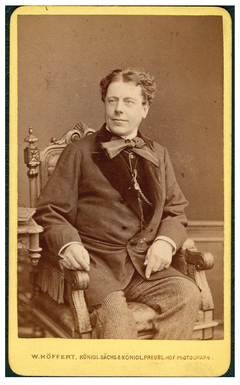
Two examples of nineteenth-century Carte dVisite, one of the earliest forms of commercial portrait photography.


